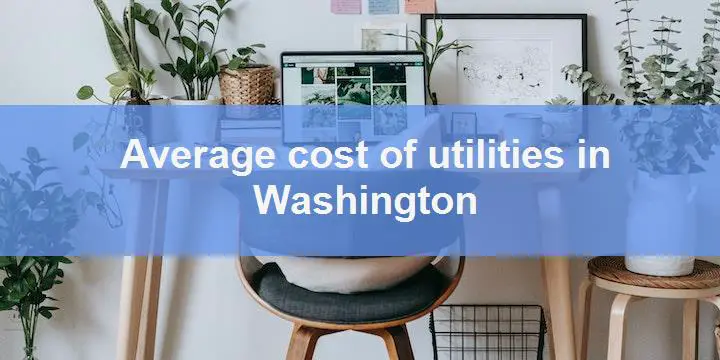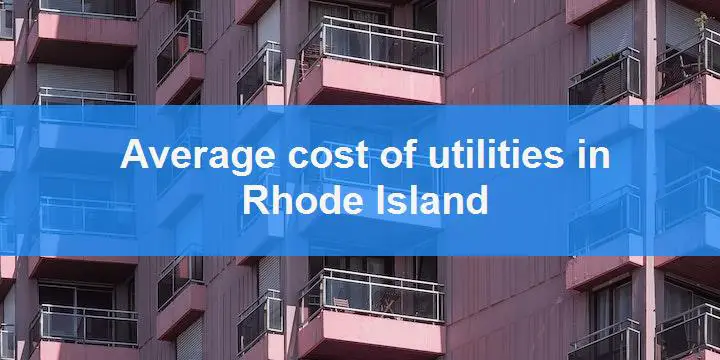Planning your household budget in Washington starts with understanding utility expenses. For a typical family of three living in a single-family home and using standard appliances throughout the year, the average cost of utilities in Washington is $607.82 in 2025. Washington’s diverse landscape—from its rainy coastal regions to its drier inland areas—plays a significant role in influencing utility costs. In this article, we’ll break down these expenses based on different household setups and seasonal variations to give you a clear picture of utility costs across the state.
Average Electric Bill in Washington
Managing your household budget in Washington starts with understanding electricity costs. For a family of three living in a single-family home, the average electric bill in Washington is $121.25 in 2025. Washington’s climate—with its mild winters and warm summers—plays a key role in electricity usage, impacting heating and cooling needs throughout the year. This average includes both winter consumption ($145.81) and summer usage ($96.69).
Washington vs. Oregon: Summer Energy Cost Comparison
Curious about how Washington stacks up against its neighbor? The table below compares electricity costs for a large single-family home with four people during the summer in Washington and Oregon. This comparison offers valuable insights into how climate differences and energy consumption habits affect utility costs between the two states.
| Criteria | Washington | Oregon |
|---|---|---|
| Total Consumption (kWh) | 862.12 kWh | |
| Electricity Rate (cents/kWh) | 11.98 ¢/kWh | 14.71 ¢/kWh |
| Estimated Monthly Cost | $103.28 | $126.82 |
| Detailed Cost Breakdown | ||
| Base Usage: 412.12 kWh | $49.37 | $60.62 |
| Refrigerator: 120 kWh | $14.38 | $17.65 |
| Air Conditioner: 240 kWh | $28.75 | $35.3 |
| Clothes Dryer: 90 kWh | $10.78 | $13.24 |
| Washington estimated monthly cost is lower than Oregon by 18.56%. | ||
Historical Trends in Electricity Prices
The historical chart above illustrates electricity price trends for large single-family homes in Washington during the summer. It helps you identify patterns in energy costs over time, offering useful insights for planning your budget more effectively.
Electricity Cost Comparison Across Various States
Here is a detailed comparison of electricity costs across different states, considering various household types and seasons. This table offers a comprehensive view of utility expenses.
| State | People | Household Type | Season | Appliances | Electric Monthly Bill |
|---|---|---|---|---|---|
| New York | 3 | One-bedroom apartment | Summer | Fridge, AC, Dryer |
$148.77 |
| Texas | 3 | Townhouse | Winter | Heater, Dryer, Fridge |
$168.56 |
| Florida | 3 | Single-family small | Summer | Fridge, AC, Washer |
$102.05 |
| Georgia | 2 | Studio | Winter | Heater, Fridge |
$123.20 |
| Illinois | 3 | Single-family small | Summer | Fridge, AC, Dryer |
$121.94 |
| Virginia | 2 | Two-bedroom apartment | Summer | Fridge, AC, Washer |
$89.33 |
| Washington | 2 | Townhouse | Summer | Fridge, AC, Washer |
$79.37 |
For a more detailed and personalized utility expense estimate, explore our Electricity Bill Calculator. Adjust the parameters to match your household specifics and get an accurate estimate tailored to your needs.
Average Gas Bill in Washington
When it comes to managing household expenses in Washington, understanding your gas bill is key. For a family of three living in a single-family home, the average gas bill in Washington is $196.93 in 2025. Washington’s climate—marked by mild winters and warm summers—directly influences gas consumption, especially for heating in the colder months and appliances like grills and water heaters during the summer. This average reflects both winter usage ($288.45) and summer consumption ($105.40).
Washington vs. Oregon: A Summer Gas Usage Comparison
Curious about how gas expenses in Washington stack up against Oregon? The table below compares gas costs for a large single-family home with four people during the summer in both states. This comparison highlights how factors like climate, household energy habits, and appliance usage influence gas bills in neighboring regions.
Gas Bill Comparison Overview
| Criteria | Washington | Oregon | Avg. USA |
|---|---|---|---|
| Total Consumption (MCF) | 6.99 MCF | ||
| Gas Rate ($/MCF) | $18.01 | $17.39 | $17.73 |
| Estimated Monthly Cost | $125.92 | $121.59 | $123.97 |
| Appliance Cost Breakdown | |||
| Outdoor Grill | $9.94 | $9.60 | $9.79 |
| Water Heater | $72.90 | $70.39 | $71.77 |
| Gas Stove | $16.57 | $16.00 | $16.31 |
| Gas Oven | $26.51 | $25.60 | $26.10 |
| Washington's estimated monthly cost is higher than Oregon by 3.56%. | |||
| Washington's estimated monthly cost is higher than the Avg. USA by 1.57%. | |||
The historical chart above illustrates gas price trends for large single-family homes in Washington during the summer. It provides valuable insights into how gas costs have fluctuated over the years, helping you anticipate future trends and better manage your household budget.
Gas Cost Comparison Across Various States
Here is a detailed comparison of gas costs across different states, considering various household types and seasons. This table offers a comprehensive view of utility expenses.
| State | People | Household Type | Season | Appliances | Gas Monthly Bill |
|---|---|---|---|---|---|
| New York | 3 | Townhouse | Summer | Water heater, Stove, Oven |
$88.71 |
| Alaska | 2 | Studio | Summer | Water heater, Stove, Oven |
$36.22 |
| Vermont | 4 | Single-family small | Winter | Gas heating, Dryer, Oven |
$298.95 |
| Texas | 3 | Townhouse | Winter | Gas heating, Dryer, Oven |
$279.14 |
| Illinois | 3 | Single-family small | Summer | Water heater, Stove, Oven |
$79.83 |
| South Carolina | 4 | Single-family large | Summer | Water heater, Stove, Oven |
$134.85 |
| Michigan | 2 | Studio | Winter | Gas heating, Dryer, Oven |
$99.20 |
For a detailed and personalized utility expense estimate, explore our Gas Bill Calculator. Customize the parameters to fit your household specifics and get an accurate estimate tailored to your needs.
Average Water and Sewer Bill in Washington
When planning a move to or investing in Washington, it’s essential to understand the costs associated with water and sewer services. In 2025, the average water and sewer bill in Washington is $75.00, a key factor that can significantly influence your household budget and long-term financial planning.
How Washington Compares to Other States
To give you a broader perspective, here’s a comparison of Washington’s average water and sewer fees with those of eight neighboring states:
| State | Average Water and Sewer Fees |
|---|---|
| Oregon | $76.00 |
| California | $77.00 |
| Idaho | $48.00 |
| Nevada | $46.00 |
| Montana | $58.00 |
| Utah | $58.00 |
| Colorado | $39.00 |
| Arizona | $64.00 |
Washington’s fees are relatively competitive, especially when compared to states like California and Oregon, where higher demand and resource management costs often drive up prices.
Sustainable Water Management Practices
Washington is a leader in sustainable water management, thanks to its diverse climate and strong environmental focus. Here are some key practices that help keep water systems efficient and eco-friendly:
- Hydroelectric Power Integration: Washington’s reliance on hydroelectric power supports both clean energy production and effective water resource management.
- Forest Management: Healthy forests play a crucial role in maintaining water quality by reducing runoff and supporting watershed health.
- Urban Green Spaces: Initiatives like green roofs and rain gardens help manage stormwater, reduce flooding risks, and improve water quality in urban areas.
- Smart Infrastructure Investments: Investments in modern public transportation indirectly support sustainable water management by reducing overall resource consumption.
Community Programs Supporting Water Conservation
Washington offers a variety of programs designed to encourage residents to adopt water-saving practices:
- Rainwater Harvesting Incentives: Financial incentives are available for installing rainwater collection systems, which help reduce dependence on municipal water supplies.
- Smart Water Technology Grants: Grants are provided to support the adoption of smart water meters and leak detection systems that promote efficient water use.
- Public Education Campaigns: Statewide programs educate residents about water conservation techniques, helping to foster sustainable habits.
Protecting Washington’s Natural Resources
Washington’s commitment to environmental stewardship ensures the preservation of clean, safe water for generations to come. The state’s proactive approach to sustainability benefits not just the environment, but also the health and well-being of its residents.
Conclusion
Drawing from my extensive real estate experience, I can confidently say that Washington’s water and sewer fees strike a balance between cost-efficiency and sustainability. Combined with the state’s forward-thinking environmental practices and strong community support, Washington is an excellent choice for homeowners and investors. Our team is here to help you navigate these factors, providing expert advice to support your real estate decisions in this environmentally conscious state.
Garbage/Trash Removal Costs in Washington
When it comes to managing household expenses in Washington, understanding waste management costs is key. The average cost for garbage and trash removal services in Washington in 2025 is around $30.00. These costs can vary based on factors such as service frequency, bin size, and whether additional recycling or composting services are included.
Washington is recognized for its strong environmental sustainability efforts, with extensive recycling and composting programs statewide. While these initiatives can influence the overall cost of waste removal, they also promote a cleaner, greener environment—making every dollar spent an investment in sustainability.
How Washington’s Waste Management Costs Compare to Other States
To provide a clearer picture, here’s a comparison of Washington’s average garbage and trash removal costs with those of neighboring states:
- Oregon: $30.00
- California: $35.00
- Idaho: $27.00
- Montana: $25.00
- Nevada: $29.00
- Utah: $24.00
- Arizona: $25.00
- Colorado: $28.00
- New Mexico: $25.00
- Texas: $25.00
- Wyoming: $25.00
From this comparison, it’s clear that Washington’s garbage removal costs are relatively moderate. States like Oregon and California tend to have higher costs due to extensive urban centers and comprehensive waste management systems. In contrast, Washington benefits from a balanced approach that combines efficiency with sustainability.
Smart Budgeting for Waste Management
Understanding your local garbage removal costs isn’t just about budgeting—it’s also about making informed decisions that support eco-friendly practices. By choosing waste management services that prioritize recycling and sustainability, you’re contributing to a healthier environment while managing your expenses wisely.
If you have any questions or need personalized insights into managing your utility costs in Washington, our team is here to help. We’re committed to providing expert guidance to help you make the most of your household budget.
Internet and Cable TV Costs in Washington
Staying connected is a key part of modern life, and managing these expenses effectively can make a big difference in your household budget. The average internet and cable TV costs in Washington in 2025 are around $116.32. These costs can vary significantly depending on your location, service provider, and the type of plan you choose.
Washington offers a wide range of internet and cable TV providers, ensuring that residents have multiple options to fit their needs. This competitive environment helps keep prices reasonable while maintaining high service quality, whether you’re in Seattle’s urban core or more rural parts of the state.
Internet and Cable TV Provider Pricing in Washington
Here’s a detailed comparison of prices from some of the major internet and cable TV providers in Washington:
| Provider | Internet Price | Cable TV Price | Bundle Price |
|---|---|---|---|
| Comcast | $62.99 | $73.99 | $117.99 |
| Verizon | $63.99 | $74.99 | $123.99 |
| AT&T | $57.99 | $68.99 | $106.99 |
Each provider offers a variety of packages, so it’s important to compare not just prices but also internet speeds, channel lineups, and additional features to find the plan that best fits your household’s needs.
How Washington’s Costs Compare with Other States
To give you a broader perspective, here’s how Washington’s average internet and cable TV expenses compare with neighboring states:
- Oregon: $116.32
- California: $116.32
- Nevada: $116.32
- Idaho: $112.66
- Montana: $112.66
- Utah: $113.66
- Arizona: $112.66
- Colorado: $113.66
From this comparison, it’s clear that Washington’s internet and cable TV costs are competitive, especially when compared to states like California, where prices tend to be higher due to increased demand in larger metropolitan areas. However, rural areas in Washington might experience slightly higher costs due to limited provider options.
Tips for Getting the Best Value
To get the most value from your internet and cable TV services, we recommend regularly comparing providers and plans. Look for promotional offers, consider bundling services, and don’t hesitate to negotiate with your provider—especially if you’ve been a long-term customer. 🌐📺
Need help navigating your options? Our team is here to guide you through the best deals in Washington, ensuring you get the right plan at the best price.
Home Phone and Mobile Phone Costs in Washington
Staying connected is essential in today’s world, and managing phone expenses effectively can make a big difference in your household budget. The average home phone and mobile phone costs in Washington in 2025 are around 68.32. These costs can vary based on your location, service provider, and the type of plan you choose.
Washington offers a wide range of phone service providers, ensuring residents have multiple options to suit different budgets and communication needs. This variety fosters healthy competition, helping to keep prices reasonable while maintaining high service quality across both urban and rural areas.
Phone Service Provider Pricing in Washington
Here’s a detailed comparison of mobile and home phone prices from some of the major providers in Washington:
| Provider | Mobile Phone Price | Home Phone Price |
|---|---|---|
| Verizon | $73.99 | $40.99 |
| AT&T | $67.99 | $32.99 |
| T-Mobile | $62.99 | Not Available |
Each provider offers different plans and packages, so it’s important to compare options based on factors like coverage, data limits, and additional features to find the plan that best fits your needs.
How Washington’s Costs Compare with Other States
To provide a broader perspective, here’s how Washington’s average home phone and mobile phone expenses compare with neighboring states:
- Oregon: 68.32
- California: 66.66
- Nevada: 64.66
- Idaho: 68.32
- Montana: 63.66
- Utah: 65.66
- Arizona: 64.66
- Colorado: 63.66
From this comparison, it’s evident that Washington’s phone costs are competitive, especially when compared to neighboring states like Oregon and Idaho. This highlights the importance of shopping around to find the best deals tailored to your communication needs.
Tips for Getting the Best Value
To get the most value from your phone services, we recommend:
- Regularly comparing providers and plans to take advantage of new deals.
- Bundling services (if available) to save on combined costs.
- Negotiating with your current provider—especially if you’re a long-term customer.
📞 Pro Tip: Always check for promotions or limited-time offers when switching providers or upgrading plans. These can lead to significant savings!
Final Thoughts
It’s crucial to stay informed and regularly review the different providers and packages available for home and mobile phone services. This approach ensures you get the best value for your money. Remember, prices and service offerings can change frequently, so checking back often is key to making the best choices. 🌟
We update this article monthly with the latest rates and insights—be sure to visit regularly for the most up-to-date information!
FAQ
Q: 💡 What is the average monthly electric bill in Washington in 2025?
A: The average monthly electric bill for Washington residents in 2025 is approximately $121.25.
Q: 🔥 What is the average monthly gas bill for Washington residents in 2025?
A: The average monthly gas bill for Washington residents in 2025 stands at approximately $196.93.
Q: 🚰 What is the average monthly water and sewer bill in Washington in 2025?
A: The average monthly water and sewer bill in Washington in 2025 is around $75.00.
Q: 🗑️ What is the average monthly garbage and trash removal cost in Washington in 2025?
A: The average monthly garbage and trash removal cost in Washington in 2025 is about $30.00.
Q: 📡 What is the average monthly internet and cable TV bill in Washington in 2025?
A: The average monthly internet and cable TV bill in Washington in 2025 is approximately $116.32.
Q: 📱 What is the average monthly home and mobile phone bill in Washington in 2025?
A: The average monthly home and mobile phone bill in Washington in 2025 is around 68.32.
Q: 🧾 What is the total average monthly cost of utilities in Washington in 2025?
A: The total average monthly cost of utilities in Washington in 2025 is approximately $607.82.



